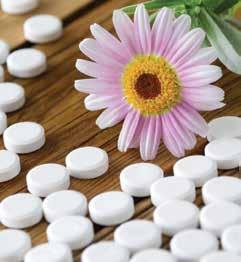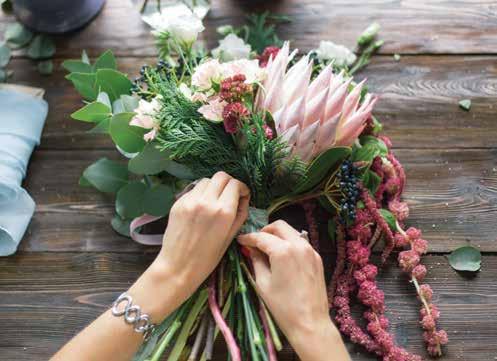
10 minute read
THE MATRIX OF LIFE
THE MATRIX OF LIFE Boosting Collagen for Better Health

Advertisement
by Maya Whitman
We need to get angry and understand what is at stake. And then we need to transform that anger into action and to stand together united and just never give up. ~Greta Thunberg

Collagen, a protein, holds us together from the inside-out, helping to build bones and providing the scaffolding that knits our bones and organs together. Stress and poor lifestyle habits, such as smoking and eating too much sugar, can contribute to its breakdown and accelerate the aging process, but strategic dietary choices and supplements can have a significant positive impact on our skin, as well as underlying conditions.
Although celebrated for its cosmetic effects, “Most people are surprised to learn that collagen is equally important for blood vessels and tissues surrounding and supporting the internal organs,” says Pamela Schoenfeld, a dietitian and nutritionist in Raleigh, North Carolina, and author of The Collagen Diet: Rejuvenate Skin, Strengthen Joints and Feel Younger by Boosting Collagen Intake and Production. Collagen is mostly found in tendons, ligaments and skin, and is also abundant in bones, cartilage, muscles, corneas, blood vessels, the gut, vertebrae discs and teeth.
In studies, collagen supplements show promise for joint pain, arthritic conditions, osteoporosis and heart health. A Penn State study of 147 student athletes found that those that took 10 grams of collagen hydrolysate daily for 24 weeks had significantly less joint pain while walking and at rest compared to a placebo group. A 2012 study featured in Complementary Therapies in Medicinefound that 1,200 milligrams of collagen hydrolysate taken daily decreased joint pain in older people by 20 percent compared to a placebo. In a 2018 study, post-menopausal women that took five grams of collagen daily for a year had better bone buildup and less bone degradation. A 2017 Japanese study of 31 healthy adults found that those that took 16 grams of collagen daily had more flexible arteries after six months.
Essential Foods Collagen health starts with our diet. Leafy greens and jewel-toned, lycopenerich vegetables, like beets, red peppers, tomatoes, berries and pomegranates, as well as seeds, including chia, sunflower and pumpkin, all pack a collagen punch. Schoenfeld recommends bone broth, too, for its joint-lubricating molecules called glycosaminoglycans, which hold many times their weight in water.
Kellyann Petrucci, a naturopathic doctor in Philadelphia and author of Dr. Kellyann’s Bone Broth Diet, concurs: “Bone broth is more than a soup. It’s concentrated healing and contains a bioavailable form of collagen your body can use immediately. It contains calcium, magnesium, phosphorous, collagen, glucosamine, chondroitin, amino acids and
so much more.” She also recommends sulfur-rich foods like eggs, broccoli, onions, garlic and cauliflower, as well as shellfish and red meat in moderation for copper. “Copper activates the enzyme that is critical in producing collagen,” she explains.
Also important, according to Petrucci, is vitamin C: “If you’re depleted of vitamin C, your body won’t make any collagen. Experiment with broccoli, kiwi, tomatoes and various citrus fruits. Bioflavonoids also improve the ability of vitamin C to be absorbed and utilized.”
Schoenfeld recommends chicken, including the skin; omega-3-rich fish with edible bones, such as sardines and canned salmon; and proline-rich, aged cheeses and yogurt. “Gelatin is also a fantastic way for the whole family to enjoy collagen and can be added to foods high in water like soups, stews, hot cereals, as can bone broth and collagen powders,” she says.
Supplements A 2019 review of 11 studies published in the Journal of Drugs in Dermatology found that oral collagen hydrolysate or tripeptide at dosages ranging from 2.5 grams to 10 grams a day increased “skin elasticity, hydration and dermal collagen density” and showed promise for wound healing and skin aging. Aloe vera, ginseng, berries, garlic, hyuralonic acid and red light therapy also boost collagen production, according to osteopathic physician and author Joseph Mercola.
For vegans, British homeopath Melissa Foreman recommends homeopathically-based minerals known as tissue salts at low potency, “which offer the benefits of meat-derived collagen and bone broth without having to ingest a meat product.” She personally relies on a combination of Nat phos, Calc phos and Kali sulph to promote new skin cells and improve the skin cell matrix. “These remedies are totally animal-free,” she says. “You can produce a supplement similar to collagen powder and it has the same health benefits of bone broth.”
Homeopathic physician Melissa
Foreman, of Brighton, England, recommends the following tissue salts: Homeopathic Collagen-Boosters
Calc phosfor strengthening bones and easing stiff joints, is particularly recommended for active people, aging athletes and menopausal women. It supports growth, builds cells, supports teeth and nail strength, and helps ease irritable bowel syndrome.
Calc fluorpromotes elasticity and flexibility. It’s essential for tendon and bone health; softens, strengthens and tones the skin; and helps when the digestive organs have lost their elasticity and become compromised.
Silica is found in hair, nails and bones. It decreases inflammation, eases painful joints, supports and strengthens nails, encourages new hair growth and improves the length and quality of eyelashes.
Nat Mur brings moisture to the skin and regulates the moisture content of every cell in the body. It promotes hydrochloric acid, helping to prevent heartburn, bloating, colic and flatulence.

Nat phos is known as the antacid of the biochemical world and like collagen, can protect the gut by neutralizing acids.
My great hope is to laugh as much as I cry; to get my work done and try to love somebody and have the courage to accept the love in return. ~Maya Angelou



TAKE CONTROL OF YOUR OWN HEALTH WITH AN AT-HOME TEST.
Convenient, confi dential and accurate health testing for women and men with online results in a matter of days. Catered with you in mind, our wellness tests include fertility & hormone, thyroid, cancer screening, general wellness, sexual health and more.
Order the right test for you. Collect your sample. Confi dence.

Visit LetsGetChecked.com today.
20% OFF EVERYTHING Use Code LIFE20 at cart.
FLOWER WOW-ER Beautiful Floral Designing
by April Thompson F resh-cut flowers can elevate a space with color, scents and textures that draw the eye and nose, but professional floral designs can be pricey. DIY arranging, however, is an easy, fun and inexpensive creative outlet that can also help cultivate mindfulness. Flower arranging is more than just a decorative art; it’s a spiritual activity that helps create a kinship with nature and merge the indoors and outdoors.
Ikebana, the Japanese art of flower arranging, dates back to the seventh century, when floral offerings were made at Buddhist altars, according to Jeanne Ha, owner of the Washington Flower School, in Takoma Park, Maryland. In the 16th century, Japanese samurais practiced flower arranging prior to combat to help calm them and stay centered, a stress-reducing activity most of us can benefit from today. “Seasonal flowers are an important element of Ikebana,” says Ha, part of a longstanding Japanese tradition of appreciating plants and flowers throughout the four seasons. Finding a Floral Style As with any artistic medium, creative choices are important in floral arranging. We can opt for a fussy, formal style, a rustic farmhouse look or a modern, asymmetrical design. “The good news is you can’t mess up flowers. Whether multidimensional or one-sided, monochromatic or multicolored, you really can’t go wrong,” says Kathy Jentz, publisher of Washington Gardener Magazine and a flower arranging instructor in Silver Spring, Maryland.
Like a good meal, the ingredients of a bouquet are as important as how they are assembled. Start with organic, pesticidefree buds. “Look for local, seasonal flowers, which will be fresher and last longer than those flown in,” says Betty Ann Galway, a certified floral designer and instructor at the Norfolk Botanical Garden, in Virginia. Farmers’ markets, community supported agriculture CSAs and pick-your-own farms are all great places to find locally, sustainably grown flowers, according to Jentz. To The good news is you can’t mess up flowers. ~Kathy Jentz
select for long shelf life, look for fresh-looking stamens and foliage, and firm heads on flowers. Mums, carnations and asters will last up to three weeks, says Galway.
When selecting flowers, Ami Wilber, floral and event décor designer at the Washington, D.C., Hillwood Estate, Museum & Gardens, recommends starting with a color scheme, whether limiting the palette to one or two colors, using analogous colors like pinks and purples or selecting complementary colors like blues and oranges. “It’s also good to find a focal flower or a show-stopper that will immediately draw attention to a bouquet,” says Wilber.
Prepping the flowers before arranging will also prolong an arrangement’s longevity, including cutting stems diagonally to provide more surface area for water, suggests Jentz. She also recommends plunging flowers into cool water immediately after trimming their stems. Leaves pump water up the stem, so leave a few on while clearing those from the bottom that would otherwise be submerged in water, adds Galway.
There are many ways to create structure for an arrangement, most of which is often hidden. Wilber stuffs chicken wire into an opaque container and then tapes down the top with a grid of floral tape to provide more control over the direction of the stems. Ha uses floral foam, soaked to provide hydration, into which stems can be inserted at any angle to create a gravity-defying design.
Different styles of arranging draw from different principles, but many common rules of thumb apply; for example, using odd numbers of each type of flower and adding in the largest flowers first to create an anchor for the composition. For a rustic, farm-totable bouquet, look beyond just blooms to incorporate seed pods, grasses and other foliage from the backyard or woods, says Wilber. These will not only fill in gaps left by thin-stemmed flowers, but also help create contrast in texture, she adds, recommending that 70 percent of the container be green.
Once the design is complete, finetune the arrangement by stepping back to see the big-picture look and making any adjustments, removing discolored leaves and adding greenery to any bald spots, says Wilber. Many designers wrap large, flat leaves around the inside of a container for a clean, polished look that hides the stems.
Most importantly, don’t forget to stop and smell the lilacs. Let the flowers lead the design and let go of any unattainable vision of perfection. “Appreciating the flowers and being thankful is an important part of the process, too,” says Ha.
Connect with Washington, D.C. freelance writer April Thompson at AprilWrites.com.
Flower Arranging Tips From a Pro A healthy, professional-looking bouquet doesn’t take years of flower designing to achieve; these tricks of the trade will help neophyte designers get started.
To loosen up tightly wound buds, breathe on them. Hot breath will open buds up faster, says publisher and arranger Kathy Jentz.
An arranging technique Jentz recommends is clustering blossoms between the index finger and thumb of the less-dominant hand, resulting in a tight arrangement that can be held in place by a rubber band pulled up to the tops of the stems.
If working with hydrangeas or other flowers with woody stems, smash open the stems along the length to get more water circulation.
Consider upcycling common containers to make flower vases, Jentz says. “You can create recycled vases out of old jars and bottles, or use chalk paint to colorfully cover over a tin can.”
The secret sauce in flower food is simply sugar and citric acid, says Jentz, so a little lemonade mix added to the water of an arrangement will work fine in a pinch.
I find hope in the darkest of days and focus in the brightest. I do not judge the universe. ~Dalai Lama

The more you praise and celebrate your life, the more there is in life to celebrate. ~Oprah Winfrey









